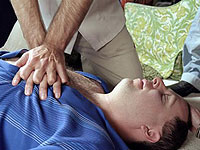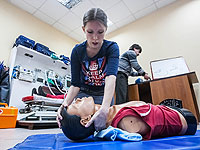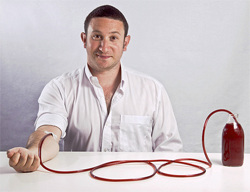What is first aid? Who knows her? Can an ordinary person learn this, and how much first aid courses are?
Content
- Why need to learn to provide first aid?
- So as not to apply and not hurt...
- Where teaching to provide first aid?
 Say salvation drowning — The work of the hands of immersing. No one is insured against an accident, and everyone hopes that in the emergency, good people will not sell by and provide the necessary first help.
Say salvation drowning — The work of the hands of immersing. No one is insured against an accident, and everyone hopes that in the emergency, good people will not sell by and provide the necessary first help.
As it came out, all the troubles happen exactly when there are no rescuers and doctors, when we are only located nearby, ordinary people: loved ones, familiar, colleagues or random passersby. From how quickly and clearly we will provide first aid, the life of the affected person is often dependent. In our power to be faster than death, we are able to protect from fire, frost, smoke, stop the bleeding, get rid of food stuck in the throat, call the Ministry of Emergency Situations and Ambulance Brigade. A common person who does not possess special medical knowledge of a person is able to snatch the victim of the chains of death, and if not returning to life, at least to extend the state when returning to a number of living remains possible.
Why need to learn to provide first aid?
According to Russian standards, the time of arrival of emergency medical care in place is an average of 5–7 minutes. But it is no secret that far from always these norms are observed. There are unclosed remote areas where doctors get difficult to get, in this case, help has to wait at least 20 minutes, and this is also provided for by law. In many cases, this time becomes critical. With the aspiration of the foreign body, drowning, stopping cardiac activity, massive bleeding and the absence of first assistance to doctors will only fix the fact of death. Conclusion: the human life directly depends on what we will do at the time while rides «ambulance».
Say we live in cruel time. Many people are calmly passing by a man who has become bad on the street or in the subway, some sympathetically turn around, stop attempting and only units are trying to help. But in most cases, the indifferent attitude of people is not related to their worn, they are simply afraid to harm and do not know what they can specifically help. Just think: simple ignorance of the first aid basics stops you from making a noble act and deprives the life of the victim.
So as not to apply and not hurt...
The legislation of the Russian Federation obliges to provide the first assistance to employees of the Ministry of Emergency Situations, Firefighters, Police and other emergency services. Simple citizens have legal right to pass by the victim, even drivers are not obliged to interfere in the fate of the fate of the life and death of a person if they do not have appropriate training.
The law frees us from responsibility for the unwinding of first aid, but how to be with responsibility to yourself, especially if a close person suffered? Undoubtedly, knowledge of first aid is necessary for everyone.
In the Holland, children from kindergarten clarify the need for first aid, we are more usually talking about the problems of alcoholism, drug addiction, smoking and cancer, although accidents in which the victims remain without the attention of others carry no less lives than terrible diseases.
Almost none of us knows how to impose harness, not to mention how to make a dressing «bagel», If a person fell to the reinforcement, and she pierced his fabrics. We do not know that it is impossible to pull out the focusing knife from the body, how to properly pack the torn finger, so that it can be sewed back, how to fix fractures and stop bleeding. Having studied all this, we can get rid of fear before providing first aid and thus will save the lives of loved ones and randomly.
Where teaching to provide first aid?
 First aid courses Essential with many organizations, in particular with the Moscow Salvation Service and the Russian Red Cross. Information on where and how training is carried out and how much it costs can be found on the Internet. Most courses last 2–3 days for very busy there are one-day training programs. For those who need a more thorough study of the issue, classes are continuing to 4–5 days. The cost of one-day courses is approximately 2,500 rubles, two-day will cost a thousand more.
First aid courses Essential with many organizations, in particular with the Moscow Salvation Service and the Russian Red Cross. Information on where and how training is carried out and how much it costs can be found on the Internet. Most courses last 2–3 days for very busy there are one-day training programs. For those who need a more thorough study of the issue, classes are continuing to 4–5 days. The cost of one-day courses is approximately 2,500 rubles, two-day will cost a thousand more.
First aid — These are the simplest events and manipulations that can save the life of the victim. In courses for studying the basics of first aid, instructors introduce listeners with emergencies and tell how to help a person wait for an ambulance brigade. For example, students learn that the person who lost the consciousness of a person needs to be put on his side so that he will not suffocate from the sparkling of the language, which can not be right in the abdominal cavity the outward intestine that artificial respiration should be done only if a person has become bad right in front of the eyes, and try to save the corpse meaningless.
The purpose of the training — Not just to convey to the listeners information about first aid, and to a greater extent to work to automatize the skills of possession of this aid, special mannequins are used in classes. Precisely because of the impossibility of mastering practical skills, remote training courses are considered ineffective.
At the end of the first aid courses, the listener is ready for any emergency, it is able to provide its own security at the scene, call the team of emergency services, in a timely manner and competently to evacuate the victims, assess their condition and provide the necessary assistance.
Instructors teach listeners how to help a person with a heart attack and stroke, with a loss of consciousness, stopping cardiac activity, drowning, suffocation by foreign bodies, cramps, bleeding, burns and injuries.
A special place is given to teaching work with witnesses at the scene and how to turn «Zewak» in their assistants and neutralize «destructive» elements, for example drunk and in the hysterics of citizens.
There are special first aid courses for those who are interested in extreme sports and recreation: tourists, climbers, climbers, fishermen, lennikov and everyone else who can be in the critical situation in the distance from civilization and medical services. In such trainings, people teach survive, to assist victims with the use of primary funds, prepare victims of transportation. The course of courses is usually flexible, if necessary, students teach what to do when heocoled and overheating, frostbite and burns, in the bite of snakes and insects, how to configure first-aid kits when traveling to the mountains, to the desert and other places.
The courses for parents are trained, how to provide first help to the child, focusing on the peculiarities of the physiology of the children's body, on typical, apparent ridiculous for an adult, situations.









